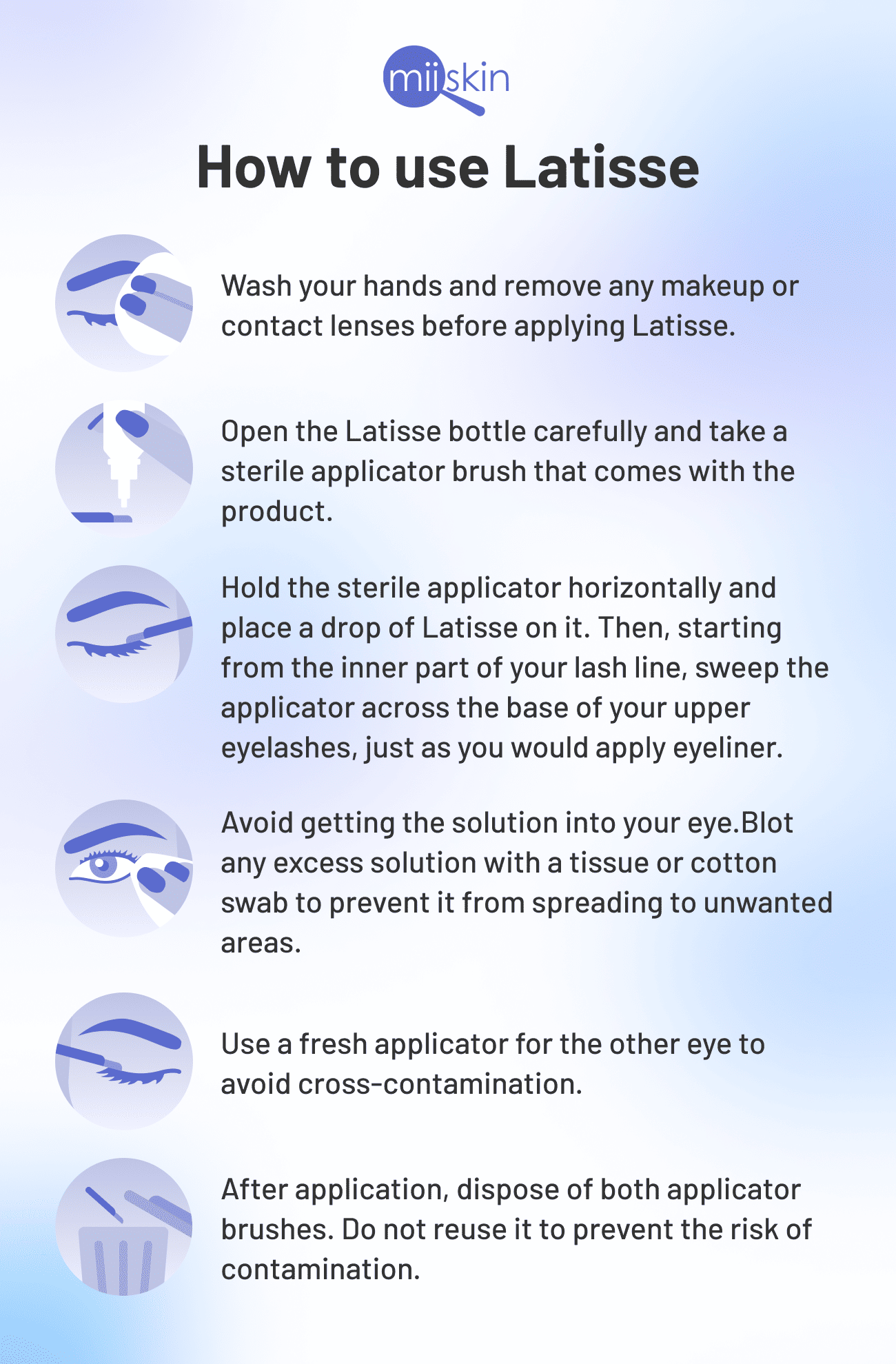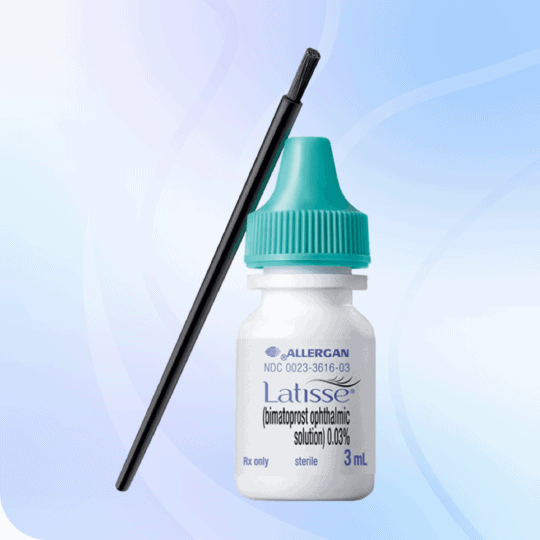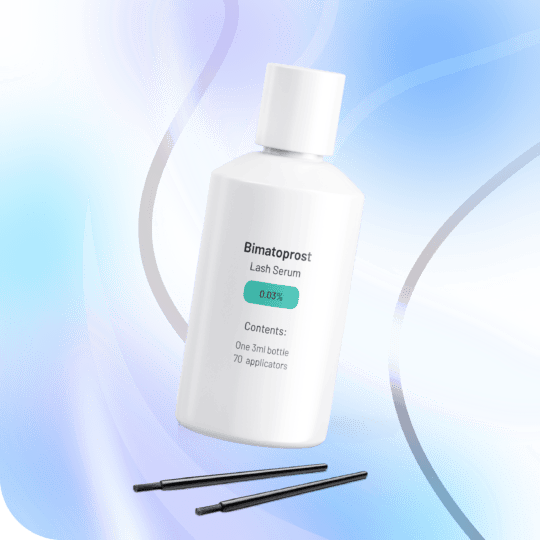A dermatologist’s guide on Latisse® lash serum
Discover essential information about the Latisse lash serum including the advantages, drawbacks, optimal application techniques and how to obtain a prescription.
Table of Content:
What is it? | How does it work? | What makes it unique? | Benefits | Side-effects | Who is it for? | Who cannot use it? | How to use Latisse? | How to get it? | How much does it cost?
Our commitment to producing high-quality content:
The information presented in this article is based on scientific research and the professional advice of our Content Medical Reviewers, who are experts in the field of Dermatology. How we write our content →
Latisse® serum for eyelash and eyebrow growth
Latisse® is prescription serum that contains bimatoprost as the active ingredient. It is FDA-approved for the growth, thickening and darkening of eyelashes. Therefore, it is also used for eyebrows1.
Since it is a prescription medication, you need a doctor’s prescription to obtain it and should only be used under medical supervision to ensure it is safe for you.
By learning about the advantages and side effects of Latisse for eyebrows and eyelashes, you can learn more about this medication and discuss with your online dermatologist if Latisse is right for you.
How does Latisse® help with eyebrow and eyelash growth?
Latisse helps enhance this natural growth process. Bimatoprost is thought to extend the anagen (growth) phase of the hair cycle and increase the number of hairs produced. The exact mechanism of how bimatoprost stimulates eyebrow and eyelash growth is not fully understood. However, scientists believe that it affects the hair follicles and the prostaglandin receptors in the eyelids. Bimatoprost is structurally similar to prostaglandins, which are naturally occurring substances in the body involved in various physiological processes 6.
When applied to the base of eyebrows and the upper eyelashes, bimatoprost in Latisse interacts with the hair follicles, possibly activating prostaglandin receptors. Scientists believe this interaction extends the growth phase of the eyelashes, allowing them to grow longer, thicker, and darker over time 7.
What makes Latisse® lash serum unique?
- The only FDA-approved eyelash serum for eyelash growth
- The only prescription-strength eyelash serum
- Clinical trials have shown its proven efficacy where participants experienced significant improvements in the length, thickness, and darkness of their eyelashes over time 8
- Has been on the market for several years, with a substantial number of users reporting positive results 9
Benefits of using Latisse® serum for eyebrows and eyelashes
- Increased eyebrow and eyelash length
- Improved thickness
- Darker eyebrows and lashes10
Potential side effects of Latisse® lash serum
- Irritation and dryness of the eyes
- Darkening of the upper eyelid
- Darkening of the iris (permanent)
- Hair growth other than eyelash line
- Allergic reactions (redness, swelling, itching) 11
Who can use Latisse® lash serum?
- Patients over 18 years of age who have insufficient eyelashes or whose eyelashes are too short or scarce
- Studies show that some patients with alopecia areata have used Latisse successfully to grow both upper and lower eyelashes12 and eyebrows
- Studies revealed that Latisse shows promise in the treatment of chemotherapy-induced madarosis (loss of eyelashes)13
Who should not use Latisse® lash serum?
Latisse should not be used by pregnant or nursing mothers or anyone under 18 years of age.
Latisse is contraindicated for patients with sensitivity to bimatoprost or patients who are currently using intraocular pressure (IOP) lowering medications.
Patients with risk factors for glaucoma or a family history of glaucoma or who have been diagnosed with elevated IOP should speak to an eye care specialist prior to starting using this medication.
Latisse should be used with caution in patients with known risk factors for macular edema14.

How to get Latisse® serum for eyebrows and eyelashes?
You can get Latisse by requesting a virtual consultation with an online dermatologist who can write you a prescription for Latisse when it’s suitable to do so. This consultation is only $59 and you can pick it up at a nearby drugstore. You will get your answer in 1-2 days.
For more detailed information on this process, you can explore our article “How to Get a Latisse® Prescription Online.”
What is the price of Latisse®?
There is a big difference between the price of generic bimatoprost (the active ingredient in Latisse) and the brand products which range from $100 to $150*.
*The price range listed here is just an estimation. Medication prices may vary depending on the state and the pharmacy selected. Miiskin is not responsible and cannot influence the price of the medication as it is independent from these entities.
Is there a generic version of Latisse®?
Yes, there is a generic version of Latisse, called bimatoprost eyelash serum that can be bought at a much cheaper than Latisse.
What happens if I get Latisse® into my eyes?
According to the manufacturer, Latisse was designed for ophthalmology use, therefore it is safe if it falls inside the eyes. You should not attempt to wash it off15.
How long does Latisse® take to work?
Clinical studies show that you can experience benefits as early as 8 weeks with best results experienced after 16 weeks of use16
Is bimatoprost the same as Latisse®?
Yes, Dr. Mohta says that bimatoprost is the active ingredient in Latisse. The two are essentially the same, though Latisse is the brand-name product designed specifically for eyelash growth.
Can you still buy Apostrophe Latisse®?
Although you cannot still buy Latisse from Apostrophe, you can request a Latisse prescription via Miiskin for $59. Medication renewals are $39 only.
Article References:
https://www.latisse.com/
https://jddonline.com/articles/the-biology-structure-and-function-of-eyebrow-hair-S1545961614S0012X/
https://www.aao.org/eye-health/tips-prevention/why-do-humans-have-eyebrows-eyelashes
https://www.ncbi.nlm.nih.gov/pmc/articles/PMC2861943/
https://www.researchgate.net/figure/Eyelash-growth-cycle-showing-the-four-phases-namely-anagen-catagen-telogen-and-exogen_fig1_312903914
https://classic.clinicaltrials.gov/ct2/show/NCT01448525
https://www.accessdata.fda.gov/drugsatfda_docs/label/2012/022369s005lbl.pdf
https://www.ncbi.nlm.nih.gov/books/NBK576421/
https://professional.latisse.com/About-Latisse/Patient-Selection
https://www.ncbi.nlm.nih.gov/pmc/articles/PMC3250027/
https://professional.latisse.com/About-Latisse/Patient-Selection







 Request a Latisse prescription
Request a Latisse prescription